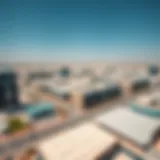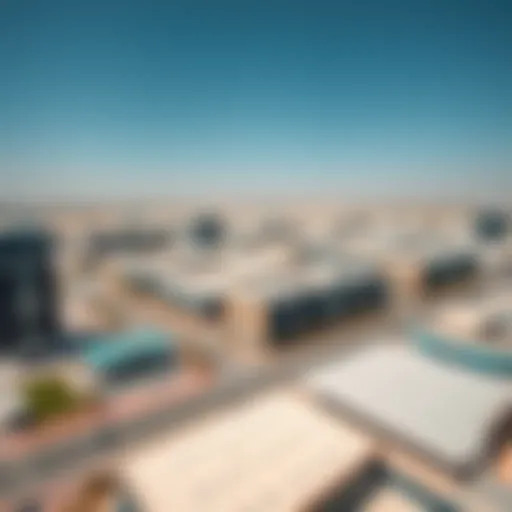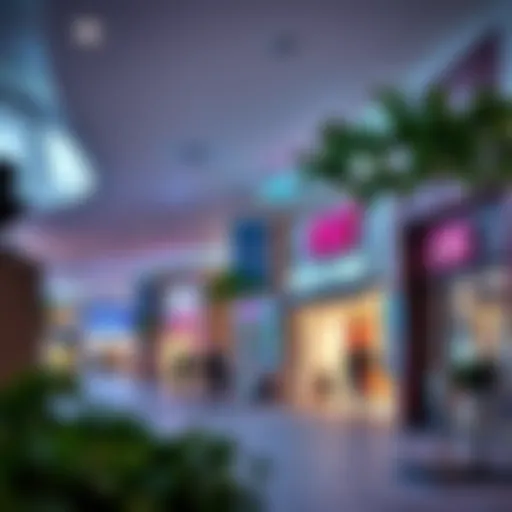Understanding the Distance Between Ras Al Khaimah and Dubai


Intro
The geographical landscape of the UAE, particularly the distance between Ras Al Khaimah and Dubai, offers a rich topic for exploration. This proximity, often taken for granted, extrudes a myriad of implications for investors, homebuyers, and even businesses that operate within the real estate market. While the physical distance might seem trivial—standing at around 112 kilometers—scholarly observations reveal that this length translates into significant repercussions in lifestyle choices, commuting patterns, and economic decisions.
Understanding this dynamic extends beyond just a map and a ruler; it involves grasping the nuances of how distance intertwines with real estate and investment opportunities. In this piece, we will delve deeply into not just the travel options available, but also examine the implications on market trends, the types of properties flourishing in this region, and the future forecasts that ripple out of this distance. Our aim is to provide granular insights, alleviating the fog of uncertainty for potential homeowners and investors alike.
Market Trends
Current Real Estate Trends in Dubai
The property market in Dubai is notoriously rapid-paced, with changes occurring almost overnight. Currently, one can observe a surge in luxury developments and a growing interest in sustainable living spaces. The influx of both domestic and international buyers has put upward pressure on prices, particularly in prime locations. Data indicates that average prices in the luxury segment have risen, showing increased buyer confidence and a recovery from past market fluctuations.
Investors are increasingly pivoting toward mixed-use developments, combining residential spaces with commercial and recreational amenities. This trend is heightened in areas closer to Ras Al Khaimah, as commuting time becomes a critical factor.
Future Forecasts for the Dubai Property Market
Looking forward, market analysts predict continued growth in the property sector, spurred on by government initiatives aimed at attracting overseas investors. Key policies—like visa extensions for property owners—are expected to propel demand further.
Expectations revolve around gradual price stabilization, coupled with phased delivery of mega projects within Dubai's borders. Should the transportation network linking Ras Al Khaimah and Dubai enhance its capacity, it could trigger a real estate boom in the areas surrounding this corridor, possibly inducing a ripple effect across the broader UAE economy.
"The distance between Ras Al Khaimah and Dubai isn't just measured in kilometers; it reflects lifestyle aspirations and investment potential that can shape the future of real estate."
Property Types
Residential Properties: Overview and Insights
Residential properties in Dubai range from opulent villas to high-rise apartments. The shift towards more affordable options in areas once deemed out of reach is a noteworthy trend. Buyers are increasingly drawn to suburban enclaves just outside Dubai, where properties are priced more competitively. In Ras Al Khaimah, for instance, brand new developments cater to families looking for spacious homes, enticing those who prefer space over proximity to the urban core.
Commercial Properties: Opportunities and Challenges
On the commercial front, Ras Al Khaimah presents a golden opportunity for businesses looking to capitalize on lower operational costs. With less competition than in Dubai, emerging enterprises find an inviting environment. However, challenges remain, particularly regarding local consumer bases and market saturation in established sectors. Investors must conduct thorough due diligence, recognizing both the potential and pitfalls present in this burgeoning market.
Overall, the distance from Ras Al Khaimah to Dubai encapsulates more than just a geographical journey; it unveils a complex interplay of market dynamics and lifestyle choices that are pivotal in shaping aspirations across the UAE.
Understanding Ras Al Khaimah
Ras Al Khaimah, one of the lesser-known jewels of the United Arab Emirates, deserves attention, especially when discussing its proximity to the bustling metropolis of Dubai. Understanding Ras Al Khaimah is not just beneficial for visitors, but also essential for investors and homebuyers who are keen on exploring the dynamics of the real estate market in this region. The emirate presents a unique blend of history, culture, and economic potential that can influence investment decisions.
The geographical positioning of Ras Al Khaimah—just a stone's throw away from Dubai—offers a compelling argument for those seeking a balance between urban convenience and a quieter lifestyle. This section aims to break down the elements that characterize Ras Al Khaimah, diving deep into its geography, culture, and economy, making it easier to grasp why this emirate is becoming a focal point for both residents and investors alike.
Geographic Overview
Ras Al Khaimah is positioned in the northern part of the UAE, bordered by the Persian Gulf to the west and surrounded by stunning mountain ranges in the east. This geographical variety contributes not only to its aesthetic appeal but also to its climate, which is slightly cooler and less humid than its southern counterparts.
In terms of distance, Ras Al Khaimah is approximately 112 kilometers away from Dubai, which translates to about an hour and a half drive under normal traffic conditions. However, during peak hours, this can stretch considerably. The road networks linking these two areas are well-maintained, making travel relatively straightforward. The convenience of access to Dubai's services while enjoying a quieter residential setting is a significant factor attracting potential homeowners.
Cultural Significance
While Dubai is often hailed for its modernity and towering skyscrapers, Ras Al Khaimah offers a rich tapestry of cultural heritage. The emirate is home to numerous archaeological sites, as well as traditional markets known as souks, where one can experience authentic emirati life.
This cultural backdrop provides a unique allure for investors and homebuyers. Living in Ras Al Khaimah offers the opportunity to immerse oneself in a lifestyle that prioritizes community and tradition. Festivals, art shows, and local cuisine add layers of charm that attract not only expatriates but also nationals looking for a taste of their heritage. Thus, it serves as a sanctuary away from the hustle and bustle of nearby Dubai.
Economic Landscape
The economic prospects in Ras Al Khaimah are on an upward trajectory. Over the past decade, the emirate has diversified its economy beyond oil and gas, focusing on tourism, real estate, and manufacturing. This shift is not just beneficial for locals; it also creates an array of investment opportunities.
Several free zones within Ras Al Khaimah facilitate business setup, making it a hub for entrepreneurs. Furthermore, the emirate's improved infrastructure supports industrial activities, and the government encourages foreign investments through favorable policies.
The growing economic landscape is a double-edged sword for investors. On one side, real estate prices are generally more affordable compared to Dubai, yet they are rising steadily as demand increases. This trend suggests that, for new investors and homebuyers, now might be the ideal time to consider Ras Al Khaimah as a viable option before prices overheat.
"Ras Al Khaimah offers a blend of tranquility and opportunity, making it a smart choice for investors looking beyond the expensive Dubai market."
In summary, exploring Ras Al Khaimah gives a clearer picture of the implications that distance from Dubai carries, impacting lifestyle choices and investment opportunities.
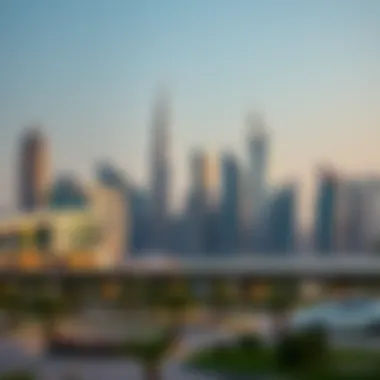
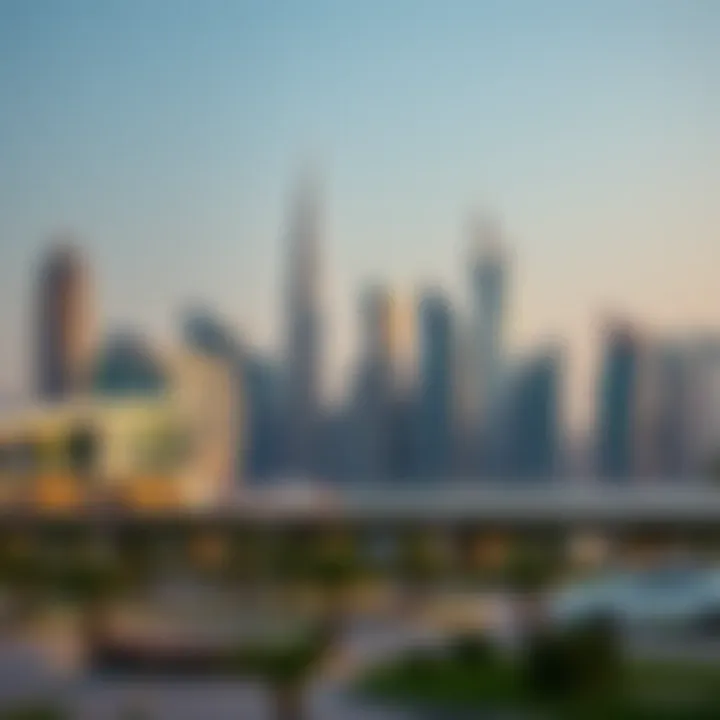
Dubai: A City Spotlight
Dubai stands tall as a beacon of progress and modernity in the UAE. Its swift transition from a small fishing village to a global metropolis is nothing short of monumental. The allure of Dubai lies not just in its glimmering skyscrapers or luxury shopping; it’s a multifaceted city teeming with opportunities and experiences that attract people from all walks of life. Within the broader discussion of distance from Ras Al Khaimah, understanding Dubai’s dynamics is crucial for potential investors and homebuyers alike.
Urban Development
At the heart of Dubai's appeal is its relentless urban development. Over the decades, the landscape has morphed dramatically, showcasing architectural marvels like the Burj Khalifa and the Palm Jumeirah. Ongoing projects spearheaded by the Dubai Land Department are set to reshape communities and fuel economic growth.
Investors should note the strategic planning behind these developments. The Dubai Urban Master Plan emphasizes sustainability and livability, promoting an amalgamation of residential space, green parks, and commercial zones. This forward-thinking approach not only increases property values but also enhances the quality of life for residents. As new opportunities arise, the proximity of Ras Al Khaimah to Dubai places it on a favorable pedestal for those eyeing real estate in the Emirates.
Real Estate Market Trends
The real estate market in Dubai is a kaleidoscope of activity, characterized by a mix of luxury and affordability. As 2023 unfolds, several trends are emerging that hold significant implications for investors.
- Shift Towards Affordable Housing: With the influx of expatriates, there’s a burgeoning demand for affordable housing options. This shift is forcing developers to balance high-end projects with more affordable units, broadening the market's appeal.
- Increased Transparency: Legal frameworks and regulatory bodies, such as the Real Estate Regulatory Agency, are continuously working to enhance market transparency. This not only builds investor confidence but also opens the doors to international buyers looking for secure investment avenues.
- Sustainability in Focus: Green buildings and eco-friendly residences are rapidly gaining traction. Developers are integrating sustainable practices in project design, aligning with global trends. This increases the market's value and attracts environmentally-conscious buyers.
The real estate landscape of Dubai is a living, breathing entity that evolves in response to economic conditions and societal needs, making it essential for potential investors to stay updated.
Lifestyle and Amenities
Dubai is not merely about concrete and steel; the lifestyle it offers is equally compelling. From vibrant culinary scenes to world-class entertainment and cultural experiences, it has something for everyone.
- Culinary Diversity: The melting pot of cultures has led to a culinary explosion, boasting restaurants that serve everything from traditional Emirati dishes to cutting-edge global cuisine. The annual Dubai Food Festival is a testament to this gastronomic richness.
- Recreational Facilities: Whether one enjoys lounging on pristine beaches, shopping in opulent malls, or participating in adrenaline-pumping activities like desert safaris, Dubai caters to diverse preferences and lifestyles.
- Cultural Institutions: With institutions like the Dubai Opera and the Dubai Museum, there's a concerted effort towards preserving and promoting art and culture. Events like Ramadan Night Markets also celebrate the rich traditions of the UAE.
In a nutshell, the lifestyle that Dubai offers adds substantial value to the real estate market. For potential buyers from Ras Al Khaimah, it's not just about the physical distance; it's about the cultural and lifestyle pull that Dubai exerts, making it essential to consider not only the practicalities of distance but the dreamy allure of the city as well.
"Living in proximity to Dubai opens doors to opportunities that extend beyond real estate; it encompasses lifestyle, culture, and connection."
Distance Overview
Understanding the distance from Ras Al Khaimah to Dubai serves as a cornerstone for a variety of discussions within this article. The measurements themselves are not just numbers; they evoke considerations around travel, investment opportunities, and lifestyle choices. This distance holds significant weight for investors, homebuyers, and anyone considering a transition between these two Emirates.
The distance between these two locations impacts everything, from commuting ease to real estate pricing. Investors need to keep an eye on this distance as it influences market trends. Homebuyers often regard the distance as a critical factor in deciding where to settle down. This overview will break down the nuances involved, providing clarity on how this seemingly simple metric affects broader economic and lifestyle implications.
Measuring the Distance
When we talk about the distance from Ras Al Khaimah to Dubai, one must consider that the measurement can differ based on modes of travel. The straight-line distance is about 112 kilometers. However, the actual travel distance can be longer depending on the route chosen.
One popular route takes travelers through the Sheikh Mohammed Bin Zayed Road, an easily navigable highway that connects the two areas. This route, while more scenic, can be subject to traffic congestion, especially during peak hours.
Here’s a quick look at the distances associated with various modes of transport:
- Private Car: Approximately 112 km, usually takes about 1.5 hours under normal traffic conditions.
- Public Transport: Buses operate between the two areas with travel times ranging from 2 to 3 hours, depending on the waiting times and the route.
- Taxis: Similar to private cars, but the meter can increase quickly, especially in heavy traffic.
While physical distance may seem straightforward, the actual experience of traveling can vary greatly. Travelers often have to navigate variables like road conditions, time of day, and even tourist seasons to gauge how long it will really take to make the journey.
Comparison with Other Emirates
In examining distances across the United Arab Emirates, it's enlightening to see how Ras Al Khaimah stacks up against its neighboring emirates.
For instance, the distance from Ras Al Khaimah to Abu Dhabi is roughly 300 kilometers, quite a stretch compared to the 112 kilometers to Dubai. This makes commuting from Ras Al Khaimah to Dubai relatively more attractive for daily travelers.
Consider these comparisons to gauge the inter-emirate distances:
- Ras Al Khaimah to Sharjah: Approximately 80 km
- Ras Al Khaimah to Ajman: About 60 km
- Ras Al Khaimah to Fujairah: Close to 100 km
This relative proximity to Dubai contributes to the ongoing interest in Ras Al Khaimah, especially for those looking to invest or buy property. Those looking for a quieter lifestyle but still wanting easy access to the hustle and bustle of Dubai find this distance appealing.
"The tangible connection between Ras Al Khaimah and Dubai empowers residents with both tranquility and opportunity. It is a crossroads of convenience and leisure."
Ultimately, understanding these distances and the implications of travel helps form informed decisions for potential relocations or investments.
Traveling from Ras Al Khaimah to Dubai


The journey from Ras Al Khaimah to Dubai is not just about covering a distance; it embodies a transition between two distinct lifestyles and experiences. Understanding the travel options available can greatly impact decisions for both residents and investors alike. As Ras Al Khaimah continues to grow in appeal, its proximity to the bustling urban sprawl of Dubai becomes a key consideration for those contemplating relocation or investment.
Transportation Options
When discussing how to make the journey, it's imperative to consider various modes of transportation, each with its distinct benefits and potential drawbacks. Choosing the right option can influence travel time, cost, and overall convenience.
Private Car
Driving a private car is often seen as the most appealing option for those traveling from Ras Al Khaimah to Dubai. Not only does this provide the freedom to travel at one's own pace, but it also enables a direct route from one point to another without the hassle of transfers or schedules. The roads connecting the two emirates are well-maintained, offering a smooth driving experience.
One of the key characteristics of this option lies in the flexibility it affords travelers. Owning a vehicle allows for spur-of-the-moment stops—be it detouring to grab a bite at a local restaurant or enjoying the scenery along the way. However, the downsides cannot be overlooked. Traffic congestion, particularly during peak hours, can significantly lengthen travel time.
Public Transport
Public transport is emerging as a viable and economical way to navigate the distance from Ras Al Khaimah to Dubai. Buses operated by the RAK Transport Authority and Dubai's Roads and Transport Authority (RTA) connect the two cities. This option is gaining traction due to its affordability and the eco-friendly aspect it brings to the table.
The unique feature of public transport is accessibility; for those without the means or desire to drive, it opens doors to exploring Dubai’s attractions without the complexities of parking. Yet, reliance on schedules can be a drawback. Passengers might find themselves waiting or needing to adjust their plans according to bus timings, which could lead to a less spontaneous travel experience.
Taxi Services
Taxi services, including traditional cabs and rideshare apps, offer a convenient middle ground between private driving and public transport. Taxis provide door-to-door service, which is particularly advantageous for those carrying heavy luggage or traveling with families. Booking a ride is straightforward, and rideshare apps are increasingly popular for their ease of use.
A notable characteristic of taxi services is the immediate availability; travelers can quickly get a ride whenever they need one. However, this convenience comes with a cost. Taxi fares can add up, especially for longer distances, which might not always be the most budget-friendly option for frequent travelers.
Travel Time Considerations
When contemplating the travel time from Ras Al Khaimah to Dubai, several factors come into play that can markedly affect the overall experience. Understanding peak versus off-peak hours and seasonal variations can play a significant role in planning a journey efficiently.
Peak vs Off-Peak Hours
The travel time during peak hours can be significantly longer due to the influx of commuters making their way into Dubai for work or leisure. Mornings, typically between 7 AM and 9 AM, as well as evenings from 4 PM to 7 PM, are especially congested. Conversely, off-peak travel—during late mornings or after the evening rush—can almost halve the duration of the trip, making it a smarter choice for those who can afford to schedule their travel flexibly.
This dimension of timing accentuates the importance of recognizing high-traffic periods. A leisurely approach could entail planning short trips to avoid being stuck in a jam, thus enhancing the travel experience overall.
Seasonal Travel Variations
Seasonal variations also play a critical role in how long a trip might take. For instance, during the cooler months from October to April, there is typically a spike in visitors traveling for tourism, which means more cars on the road. This uptick can lead to longer travel times than during the blazing summer months, when many people tend to stay indoors.
Moreover, events such as festivals or exhibitions in either Ras Al Khaimah or Dubai can further complicate travel dynamics. Understanding these nuances can help residents and visitors alike make informed decisions regarding the best times to embark on their journeys from Ras Al Khaimah to Dubai.
Impact on Real Estate Decisions
The distance between Ras Al Khaimah and Dubai holds significant sway over various aspects of real estate decisions. Investors and homebuyers alike often weigh in on how proximity to such a bustling hub like Dubai can influence their choices. As we dive into its implications, several factors come to light that make this exploration practical and relevant for today’s market participants.
Proximity to Dubai
Influence on Property Values
When considering real estate in Ras Al Khaimah, one cannot ignore the pervasive influence that proximity to Dubai has on property values. Properties closer to Dubai tend to command higher prices, driven by desirability and demand. There’s an undeniable allure associated with living near a city that boasts luxury shopping, cultural experiences, and employment opportunities. This characteristic makes it a sought-after location for many homebuyers who crave the vibrancy of urban life while maintaining an oasis of tranquility in Ras Al Khaimah.
- Key Features: The uniqueness of properties affected by Dubai's proximity lies in their dual advantage—access to both the calm of Ras Al Khaimah and the dynamic offerings of Dubai. Investors can typically expect potential appreciation in property values, presenting a compelling choice for those looking to make a long-term investment. The trade-off, however, could be an initial price premium.
“Location, location, location” is more than just a mantra; it’s a guiding principle in the real estate world, especially in this region.
Market Demand Analysis
Understanding market demand in Ras Al Khaimah requires insight into how Dubai impacts buyer behavior. Many prospective buyers find the balance between Ras Al Khaimah's affordability and Dubai's high-end offerings appealing. As such, those looking to invest in real estate here must appreciate the shifting trends and potential for growth.
- Characteristics: The swell in demand is often reflected in the surge of new property developments and an increase in rental prices. The drive toward exploring suburban alternatives—especially for families—positions Ras Al Khaimah as an attractive market for long-term residence, offering a relative bargain compared to its neighbor.
Lifestyle Choices
Residential Preferences
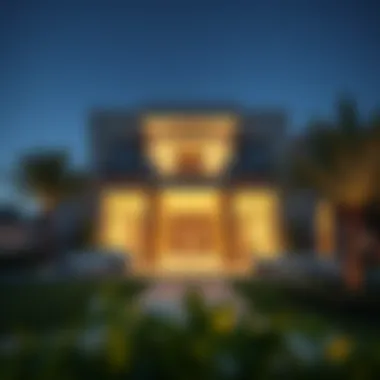
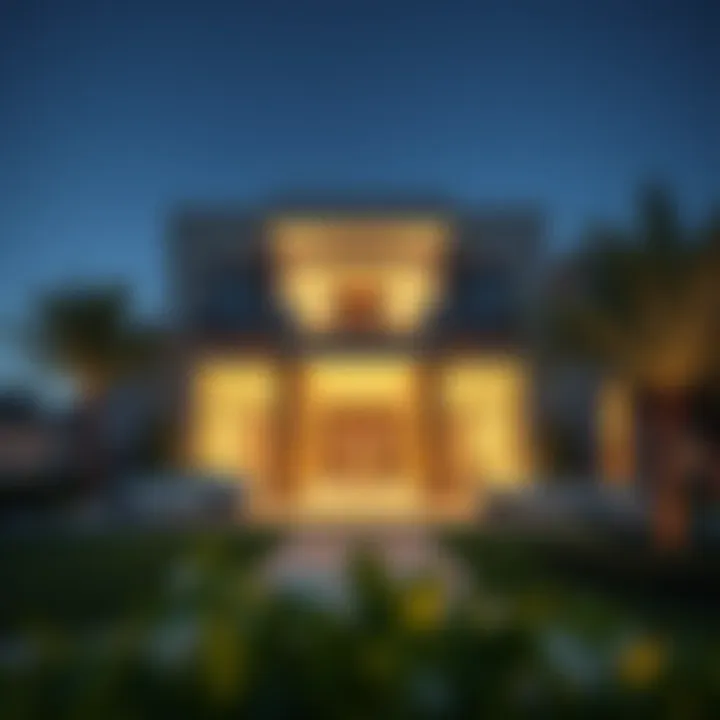
Choosing a place to live involves more than just numbers or property values; it reflects individual lifestyle preferences. In Ras Al Khaimah, residential choices often intertwine with the appeal of Dubai. The decision of where to settle down can hinge on lifestyle aspirations—whether one favors the hustle of urban life or the peaceful expanses of less densely populated areas.
- Key Insights: Those yearning for serenity may lean towards Ras Al Khaimah, finding solace in its scenic landscapes and community-oriented lifestyle. This preference broadens the market appeal among different demographics, from young professionals to families looking for spacious housing without the urban clutter.
Commute Considerations
Lastly, commuting plays a pivotal role in the decision-making process. The balance between a short commute and the lifestyle a buyer wants cannot be underestimated. Given that Ras Al Khaimah is a viable option for individuals working in Dubai, potential residents typically evaluate their daily travel time against the benefits of residing in a quieter area.
- Unique Factor: The drive from Ras Al Khaimah to Dubai—depending on the time of day—can fluctuate significantly. Understanding these commute patterns is crucial for both prospective buyers and investors, as long travel times might deter some while enticing others who find solace in the promise of a peaceful home.
Evaluating all these elements can give a clearer picture of how the proximity from Ras Al Khaimah to Dubai impacts real estate decisions, offering critical insights for investors looking for promising opportunities in this evolving landscape.
Ras Al Khaimah as an Investment Opportunity
The real estate market in Ras Al Khaimah is often overshadowed by the glimmering lights of Dubai. However, a closer look reveals a wealth of investment opportunities that deserve attention. Understanding Ras Al Khaimah's potential can prove beneficial for both seasoned investors and first-time buyers. As the UAE's northernmost emirate, Ras Al Khaimah offers a unique combination of natural beauty, traditional culture, and growing economic stability, all of which contribute to its attractiveness as an investment destination.
Real Estate Market Overview
Ras Al Khaimah's real estate market has shown resilience and growth, particularly in recent years. Prices in this emirate remain favorable compared to Dubai, allowing investors to enter the market without breaking the bank. The pricing strategy here is distinct and often more accessible.
- Affordability: Residential properties are priced considerably lower than their counterparts in Dubai. This affordability appeals to a broad range of buyers, from expatriates seeking a home to investors looking for rental returns.
- Diverse Offerings: The real estate landscape is varied, with options ranging from luxury villas to affordable apartments. This diversity caters to different market segments.
- High Rental Yields: The demand for rental properties is on the rise, driven by both locals and expatriates. Consequently, rental yields can range anywhere from 7% to 10%, making it a sound option for investors seeking income-generating properties.
Understanding these factors can position investors strategically within a market that is still following an upward trajectory.
Emerging Trends
As Ras Al Khaimah continues to evolve, several emerging trends are shaping its real estate landscape. Keeping an eye on these developments can provide valuable insights for future investors.
- Sustainability Focus: There's a growing emphasis on green building practices. Developers are looking to incorporate sustainable technologies, which not only cater to environmentally-conscious buyers but also secure government support and incentives.
- Tourism-Driven Growth: With tourism increasing, more developers are investing in hotels and vacation rentals. The emirate's natural attractions, such as stunning beaches and historical sites, make it an appealing destination for tourists.
- Infrastructure Expansion: Improvements in infrastructure, including road networks and transportation facilities, are making Ras Al Khaimah more accessible. This expanded connectivity is likely to boost the real estate value as it becomes easier for residents and visitors to travel to nearby cities like Dubai.
"Investing in Ras Al Khaimah offers not just affordable housing, but glimpses into a thriving market that looks set for growth."
In summary, Ras Al Khaimah is no longer a hidden gem, but rather a robust investment opportunity for those willing to look past the superficial shine of Dubai. By understanding the local real estate market and recognizing emerging trends, investors can reap significant rewards.
Ending: Weighing the Distance
The journey from Ras Al Khaimah to Dubai is not just measured in kilometers but also in the broader context of lifestyle, investment potential, and regional dynamics. Understanding this distance holds significance as it informs various strategic decisions for potential homeowners and investors alike. Knowing the precise distance helps one gauge travel options, daily commute times, and ultimately the practicality of living in one emirate while working or engaging in activities in another.
With Ras Al Khaimah increasingly marketed as a viable alternative to the bustling life of Dubai, it’s crucial for buyers to weigh the benefits against the implications. The allure of lower property prices in Ras Al Khaimah meets the demand for convenience and proximity to the metropolitan luxuries of Dubai. For instance, it could be easier on the wallet to invest in a family home or a vacation rental in Ras Al Khaimah, while still having access to Dubai's vibrant attractions for the weekends or occasional business meeting.
Key considerations in this balancing act include:
- Daily commuting: Assessing how much time one is willing to spend on the road daily.
- Financial implications: Considering the expenses associated with transportation when living farther from one's workplace.
- Lifestyle preferences: Reflecting on whether one prefers the relaxed pace of Ras Al Khaimah versus the fast-paced life in Dubai.
As the dynamics of the region evolve, investors and homebuyers must keep their ears to the ground.
"In real estate, it's not just about the bricks and mortar; it’s about the connections and community."
Investing in a property is often more than just a financial decision; it's deeply tied to one's lifestyle aspirations and future outlook.
Balancing Lifestyle and Investment
As the cost of living in Dubai continues to rise, many are reevaluating their choices to find a more suitable balance between lifestyle and financial expectations. Ras Al Khaimah's relatively affordable real estate makes it an attractive option for people who seek both quality of living and economic viability. Living in Ras Al Khaimah offers a different lifestyle—a blend of tranquility and access to the vibrant energy of nearby Dubai.
For families looking for spacious homes with beautiful views of the Hajar Mountains or the coastline, Ras Al Khaimah is increasingly appealing. Conversely, corporate professionals might view the commutes as manageable trade-offs for better property investment. This relocation often occurs due to:
- The relative affordability in terms of real estate prices compared to Dubai.
- The availability of various amenities that cater to families and individuals alike.
- The natural landscapes that provide more opportunity for recreation and a slower pace of life.
Looking Ahead
Future developments in infrastructure are likely to influence these dynamics even further. Projects aimed at improving connectivity—like the highway upgrades and public transport expansions—will make Ras Al Khaimah more accessible. Such advancements not only enhance commuting ease but also raise the strategic appeal to potential investors.
The upcoming trends indicate a shift toward integrated living, where urban planning considers sustainability alongside growth.
For investors and buyers, staying ahead means keeping up to date with government policies and market trends.
- monitor the evolving transportation projects that may affect accessibility
- keep an eye out for announcements regarding new community developments and business hubs.
The distance from Ras Al Khaimah to Dubai will likely continue to evolve in significance as the UAE's economic landscape transforms. Understanding this location's implications, potential benefits, and lifestyle impacts can play a pivotal role in making informed decisions.




